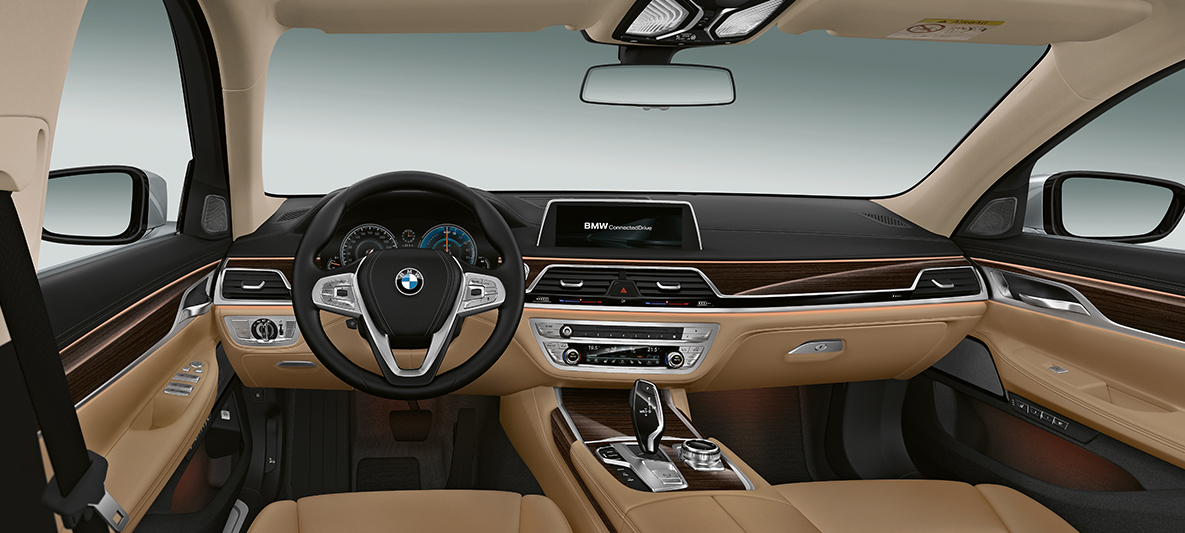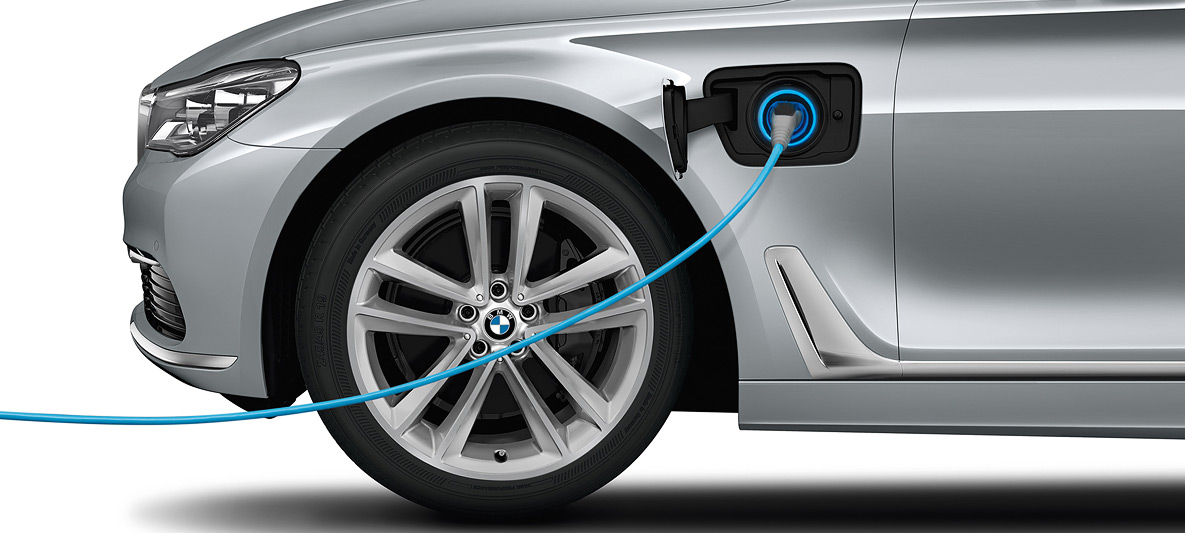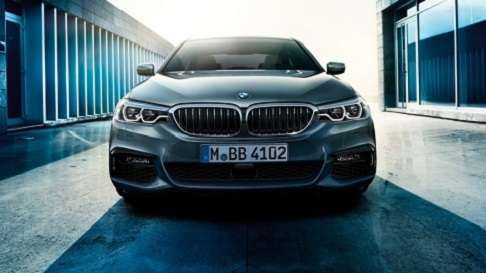Our tool for managing your permission to our use of cookies is temporarily offline. Therefore some functionality is missing.

eDRIVE. AN ELECTRIFYING DRIVING SENSATION.
The BMW 7 Series with eDrive.
The range and performance of a BMW TwinPower Turbo engine coupled with the efficiency of an electric motor: The BMW 7 Series with the BMW EfficientDynamics technology eDrive (BMW 740e, 740Le and 740Le xDrive) brings together the best of both worlds. The result is substantially lower fuel consumption with similarly reduced emissions. And a driving performance allowing the comfort and wellbeing in the BMW 7 Series to be experienced even more intensely.
The BMW eDrive models 740e, 740Le and 740Le xDrive will be available from 2016. The figures provided are the probable technical specifications.
The range and performance of a BMW TwinPower Turbo engine coupled with the efficiency of an electric motor: The BMW 7 Series with the BMW EfficientDynamics technology eDrive (BMW 740e, 740Le and 740Le xDrive) brings together the best of both worlds. The result is substantially lower fuel consumption with similarly reduced emissions. And a driving performance allowing the comfort and wellbeing in the BMW 7 Series to be experienced even more intensely.
The BMW eDrive models 740e, 740Le and 740Le xDrive will be available from 2016. The figures provided are the probable technical specifications.







VEHICLE CONCEPT.
A BMW luxury-class sedan with minimum fuel consumption figures and full dynamic characteristics in all driving modes. Thanks to its comfort and dynamics, the BMW 7 Series with eDrive confirms all expectations. The eDrive lettering on the rear indicates the electric drive. What distinguishes it above all is the range in pure electric mode. With 40 kilometres (37 kilometres with xDrive), it drives without local emissions and without consuming fuel. Even in combined mode, the CO2 emissions figure for the BMW 7 Series with eDrive is 49 g/km (53 g/km with xDrive). The high-voltage battery is stored beneath the rear seat so that a sufficient volume of the 420 litres remains for bulky luggage. A future-orientated vehicle concept that is second to none.


INDIVIDUAL DRIVING BEHAVIOUR.
As a plug-in hybrid, the BMW 7 Series with eDrive has various drive modes, with which the driver can exert a major influence on the real fuel consumption. The result in practice depends firstly on the choice of driving modes – and secondly on personal driving behaviour. When the battery is fully charged, a distance of up to 40 kilometres (37 kilometres with xDrive) can be covered purely electrically before the BMW TwinPower Turbo petrol engine switches on as well for optimum efficiency and range.
DRIVETRAIN.

A powerful BMW TwinPower Turbo 4-cylinder petrol engine and a highly efficient eDrive electric motor power the BMW 7 Series with eDrive. The system output is 240 kW (326 hp) with a combined system consumption of 2.1 l/100 km (2.3 l/100 km with xDrive)*. The intelligent all-wheel drive system BMW xDrive provides optimum traction. The combination of these BMW EfficientDynamics technologies has led to an innovative vehicle with economical consumption figures which, at the same time, offers full driving dynamics and stability on all road conditions.
* The figures for fuel consumption and CO2 are preliminary values that have not yet been confirmed. They depend on the selected tyre size.
BMW TwinPower Turbo 4-cylinder petrol engine
The innovative BMW TwinPower Turbo 4-cylinder petrol engine guarantees maximum driving pleasure thanks to agile power delivery and outstanding responsiveness at low engine speeds, all while being exceptionally fuel efficient and low in emissions.
The 4-cylinder petrol engine is a superb example of modern engine production. To enhance dynamics and efficiency, BMW uses TwinPower Turbo technology with Valvetronic fully variable valve control including Double-VANOS variable camshaft control and High-Precision Injection. This allows the engine to operate with an optimal power-efficiency factor in any load range, thereby lowering fuel consumption. This engine is part of the EfficientDynamics range and generates an output of 190 kW (258 hp) and torque of 400 Nm.Electric motor
The liquid-cooled electric motor in the plug-in hybrid is integrated into the vehicle's transmission. It has an output of 70 kW (95 hp) and delivers maximum torque of 250 Nm. Up to approx. 40 km* (37 km with xDrive*) can be covered in 100% electrical mode, reaching a top speed of up to 120 km/h.
Whenever the driver releases the accelerator, the electric motor acts as a generator, powered by the wheels, and converts kinetic energy into electrical energy in a process known as recuperation. An even higher recuperation rate is achieved when braking. Up to a certain brake pressure, the vehicle is slowed down by the electric motor alone, which at the same time converts even more kinetic energy into electricity. This free, recuperated energy can then be used to propel the vehicle via the electric motor or to power electrical components. This lowers fuel consumption and considerably improves the efficiency of the drive.
* These figures are preliminary values that have not yet been confirmed. They are based on 17'' and 18'' tyres with reduced rolling resistance.High-voltage battery
The High-voltage battery for the BMW 740e/Le is stored beneath the rear seat, keeping it secure and saving space. As a result, the luggage compartment is slightly smaller than in conventional models (420 litres).
The battery can be charged with the cable supplied, from conventional household 230 volt power sockets or at a public charging station. During travel the electric motor sometimes acts as a generator, converting kinetic energy into electricity (recuperation), which it stores in the battery.
Thanks to lithium-ion technology, the liquid-cooled High-voltage battery has a high energy density and comparably compact dimensions. With a capacity of 9.2 kWh, it can deliver up to 70 kW (95 hp) to the electric motor at a moment's notice. When fully charged, it makes a purely electric range of up to 40 km* (37 km with xDrive*) possible in a BMW 740e/Le, as well as an electric maximum speed of up to 120 km/h.
* These figures are preliminary values that have not yet been confirmed. They are based on 17'' and 18'' tyres with reduced rolling resistance.

INTELLIGENT ENERGY MANAGEMENT.
Intelligent energy management is one of the main pillars of the BMW eDrive concept. This system coordinates the interaction of all drive components in order to combine the best possible efficiency with great driving dynamics. Intelligent energy management optimises the hybrid drive's power-efficiency factor by predictively choosing the appropriate drive. For example, available navigation data is used to identify in advance the sections of the route and driving situations that are best suited for the electric motor or for charging the high-voltage battery.
In situations in which the combustion engine would have a low power-efficiency factor, the system shifts up to a higher load range with a better power-efficiency factor. That means that the combustion engine produces additional power. This power is used to create electricity for the battery via the electric motor/generator, which can later be used for electric driving or efficiently supporting the combustion engine. It also controls the electric motor/generator, so that kinetic energy is transformed into electrical energy during coasting and when braking. In combination with ECO PRO mode, intelligent energy management adapts all vehicle systems, including all auxiliary components and comfort functions, to be fuel-consumption conscious and highly efficient.
The eDrive button allows the driver to choose between three different electric drive modes. When starting the vehicle, the AUTO eDrive (hybrid) mode is active by default. The MAX eDrive mode allows a purely electric driving distance of up to 120 km/h. In the Battery Control mode, the saved electric energy is retained for later use.
AUTO eDrive mode
When starting the vehicle, the AUTO eDrive mode, i.e the hybrid mode, is active by default, and the driver can take selective advantage of the extremely efficient purely electric drive. Depending on the cargo load and charge level of the electric battery, the vehicle uses only electric energy up to a speed of 120 km/h. A power meter display in the instrument cluster informs the driver of the electric output the vehicle is currently using and the point at which additional power demands will cause the combustion engine to switch on automatically.
MAX eDrive mode
In the MAX eDrive mode – the purely electric mode – the electric drive provides the maximum output. The driver can press the accelerator to its full extent without activating the combustion engine, and the vehicle can reach a top speed of 120 km/h. When greater propulsion power is required, the combustion engine can be switched on at any time via the gear lever or by pressing the accelerator to kickdown.
Battery Control mode
In Battery Control mode, the vehicle is only powered by the combustion engine whilst it is charged to a level selected by the driver. The saved electric energy is reserved for further electric driving.
Predictive selection
Once the destination has been entered into the navigation system, predictive energy management analyses the planned route using constant data such as the speed limit and real-time information on the current traffic situation. The system then uses the purely electric driving mode efficiently and according to the situation and above all for sections of the route on which it is most worthwhile: in urban traffic for example.


CHARGING.
Home charging
The vehicle can be conveniently charged at home at a conventional household 230 volt power socket and has a 'full tank' after approximately four hours. The car's charging port is located behind a flap on the front left side panel. All that's needed for charging is the included cable, which can be stored safely and compactly in the rear left section of the luggage compartment. A special seal protects the charging port and plug from the elements. A special wall-mounted charging station or wallbox can be used instead of a normal power socket. This unit offers increased charging power, making the charging process much quicker. The charging status of the high-voltage battery can be read from the multicoloured LED light ring or obtained using the BMW ConnectedDrive App. Depending on various factors, for example the strength of the charge at the power source, the number of devices actively consuming electricity in the car during the charging process and the use of a Wallbox, it takes approximately 2.75 hours for an empty high-voltage battery to recharge completely. In addition, the passenger area can be pre-heated or cooled during external charging. As a large proportion of driving is powered purely by electricity, travel costs can be significantly reduced.
Public charging
The vehicle can be charged from household power sockets with the charging cable included and also on the go from public charging stations with a cable available from BMW accessories. That way, after going shopping, the driver can continue the journey with a 'full tank' that is free of local emissions. The car's charging port is located behind a flap on the front left side panel. All that's needed for charging is the included cable, which can be stored safely and compactly above the left wheel arch in the luggage compartment. For charging at public charging stations, a BMW Accessories cable is required. The charging time varies based on several factors, for example the current strength of the current and number of active devices consuming electricity in the vehicle.
A special gasket ring protects the charging port and plug from the elements. LED light rings on the charging port make the charging status visually clear. The navigation system and BMW ConnectedDrive App give the driver information about the location and availability of suitable charging stations.
Authentication at the charging station and monthly billing for the energy costs can also take place using the separately available ChargeNow card from the BMW mobility service ChargeNow.
Please note: ChargeNow is a fee-based service from the 360° ELECTRIC portfolio.


CONNECTIVITY.
Always connected with your BMW: in addition to BMW Remote Services such as remote locking, hybrid-specific functions are also available via smartphone (iOS or Android). This ensures that you always have an overview of the fuel consumption and efficiency figures for your BMW 7 Series with eDrive. BMW Services for every eventuality can be used inside the vehicle – and outside.
BMW ConnectedDrive App
The BMW ConnectedDrive App for iOS and Android displays detailed information regarding the current status of the BMW – such as the vehicle's location, the battery level and remaining range.
The charging procedure can be controlled remotely via the week-to-view timer, and the vehicle's temperature remotely adjusted in good time ready for the next journey. Destinations, points of interest and the location of charging stations can be easily sent from the application directly to the vehicle.
The BMW ConnectedDrive App also measures the efficiency of every trip and gives helpful tips, such as how to drive the vehicle in a more efficient manner and extend its range.Pre-conditioning
Get into a comfortably cool car in summer and a warm car in winter – stationary air conditioning in the BMW 740e/Le makes that possible. Thanks to an electrical refrigerant compressor and a tankless electrical heater, the automatic air conditioning functions almost silently, even when the engine is off. Three departure times can be programmed for every day of the week.
Half an hour before the planned departure, heating, cooling and ventilation is implemented to the selected temperature by an intelligent control system. The system is operated by the iDrive Controller inside the car, or conveniently with a compatible smartphone using the BMW ConnectedDrive App.
Provided that the high-voltage battery has a sufficient charge, the stationary air conditioning functions regardless of whether the vehicle is being externally charged or not.

